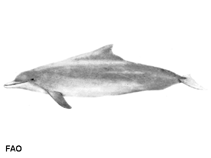Sousa chinensis (Osbeck, 1765)
Pacific humpback dolphin
Classification / Names Populärnamn | synonymer | CoL | ITIS | WoRMS
Mammalia | Cetartiodactyla | Delphinidae
Environment: milieu / climate zone / djupintervall / distribution range Ekologi
Amfidrom (Ref. 75906); brackvatten; djupintervall 0 - 500 m, usually 1 - 100 m. Tropical; 90°N - 90°S, 18°E - 155°E
Distribution Länder | FAO områden | Ekosystem | Förekomster | Utplanteringar
Indo-West Pacific. [eastern Taiwan Strait population: IUCN 2017 (Ref. 115185): CR, C2a(i,ii); D.]
Length at first maturity / Size / Weight / Age
Könsmognad: Lm 235.0, range 200 - 250 cm Max length : 320 cm TL hane/ej könsbestämd; (Ref. 1394); 250 cm TL (female); publicerad maxvikt: 284.0 kg (Ref. 1394)
Life cycle and mating behavior Könsmognad | Reproduktion | Lek | Eggs | Fecundity | Larvae
Main reference
referenser | Koordinator | Medarbetare
Jefferson, T.A., S. Leatherwood and M.A. Webber 1993 FAO species Identification Guide: Marine Mammals of the World. Rome, FAO. 320 p. + 587 figures. (Ref. 1394)
IUCN Red List Status
(Ref. 130435: Version 2025-1)
CITES status (Ref. 108899)
CMS (Ref. 116361)
Threat to humans
Human uses
Fiskeri: kommersiell
FAO - fiskeri: landings, species profile | FishSource | Sea Around Us
Verktyg
Ytterligare information
Max. ages / sizes
Length-weight rel.
Length-length rel.
Length-frequencies
Mass conversion
Abundans
Internet-källor
BHL | BOLD Systems | CISTI | DiscoverLife | FAO(fiskeri: species profile; publication : search) | Fishipedia | GenBank (genome, nucleotide) | GloBI | Gomexsi | Google Books | Google Scholar | Google | PubMed | Tree of Life | Wikipedia (Go, sök) | Zoological Record



